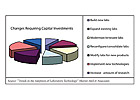
FIGURE 1. Changes requiring capital investments.
Many of today's research buildings are being built as "generic lab" buildings with the hope of attracting and recruiting researchers to rent or buy space. Universities, in particular, are building generic labs in order to appeal to researchers with grants and utilize students in their labs and collaborate with other researchers. The owners of these buildings often construct generic labs without knowing anything about the specific science they'll be used for. By doing this, they often have to spend up to 30% more in renovations to meet the researchers' specifications.
With today's changing technology, new equipment, and dynamically new emerging research, the only constant is change. And with that change is the need to have laboratories that are flexible and expandable, so they're able to meet the researchers' needs. This article examines trends with owners, changes in laboratories, and the need to design flexible generic labs. It will also take a look at engineering factors that drive airflow, which is typically the single highest energy-consuming component of any lab.
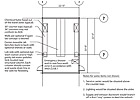
FIGURE 2. An example of a lab module.
The generic lab
What are generic labs? They are cookie-cutter labs with the same utilities, casework, lab furniture, fume hoods, configuration, etc. They are designed to be occupied by researchers who have not yet been identified. But much like the researchers who will be using them, no two labs are alike. A lab is categorized by its function, which then can be benchmarked within that function. There are a number of reasons listed below why labs need to be customized:- Different science and research being performed
- Different pieces of equipment used
- Different chemicals being used
- Different casework and lab furniture
- Wet and dry labs, computer labs, psychological evaluation labs
- Different bio-safety levels, pathogens, and tissue culture
- Different animals being used and different research done on the same type of animal
- Different lighting required, particularly for psychology
- Medical labs, chemical labs, life science labs, pharmaceutical labs
- High hazards
Even labs of the same type or function can vastly differ. For example, I once helped design a chemistry lab that was 10 stories, with an area on each floor of 37,000 sq ft. It had 16 fume hoods per floor or 2,312 sq ft/hood. I am currently working on a chemistry lab in which the client is requiring 30 hoods in a 7,000-sq-ft lab, or 233 sqft/hood. That is a hood density that differs by a factor of 100 for the same type of lab.

TABLE 1. Chemical fume hood guidelines and standards.
Owner and enduser relationship and trends
The trend among some universities and private developers is to build a high-tech research building and rent it out or sell research space as condominiums. The benefits to the owner are that they make money on the rent, or in some cases the sale of the lab space, similar to a condo. The owner can also charge maintenance fees similar to condo set-up fees.Private or public entities can contract out research with a university for a fixed fee, as long as it brings educational value for its students. Rarely is lab space provided to tenured professors as a privilege unless merit is demonstrated; that is, money is brought in to cover research and expenses for the space.
A new facility may not be fully occupied and therefore needs only the equipment and systems installed for the occupancy. As the building fills up, systems are added and capacities are increased to meet the load.
Not only do the science, equipment, and needs change but so does the personnel in a sometimes endlessly revolving door. Researchers are in high demand, and as a result, they are lured away by other institutions, often with the need of renovating their proposed lab space. Because new researchers are frequently coming in and out of institutions, the labs will likely need to be updated just as often.
Also, research labs need to be flexible because the grant and funding changes may change the research or science involved. This, in turn, changes the lab configurations, case-work, equipment, utilities, and associated capacities. Some pharmaceutical research labs change several times a year; some have been known to change as often as 19 times a year.
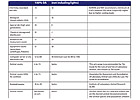
TABLE 2. Typical rules of thumb for various lab types.
Change is inevitable
Change is inevitable within the same function. It may not be feasible for a lab to change functions, say, from a dry lab to a high-hazard lab with out spending a substantial amount of capital reconfiguring the facility and systems to serve the new function.According toLaboratory Equipmentmagazine's "Laboratory Trends 2006," two thirds of researchers describe their labs' capital equipment (facilities, systems, etc.) as older and outdated. Eighty-four percent of researchers expect their organizations to make changes that will require capital investments. In addition, many of the researchers expect their organizations to adopt emerging technologies in the next two to three years.
The best scenario would be to design a facility to a specific program where the equipment, loads, capacities, and requirements are known. However, many institutions are caught in a "Catch-22" in which they need to provide a state-of-the-art facility to attract researchers and do not have the luxury of designing for a specific program. The design does not take into account the specific needs of the researchers because they have not had the ability to provide input during the planning and design process.
As a result, when the researcher does sign up and the building is already built, some kind of modification to the space provided by the landlord will most likely be required.
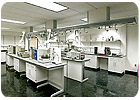
Example of plumbing gas connection service carrier. (Photo courtesy of Gas Control Equipment, Inc.)
Avoiding costly building modifications
How can the owner get around these costly building modifications? By avoiding the domino effect. If the systems in the facility are not designed for the maximum foreseeable capacity for a particular function, then all the systems down the line would be inadequately sized. For example, the air handler's cooling coils affect the chiller's size, which affects the pump size, which affects the electrical conduit size, which affects the transformer and substation size, which affects the incoming feeders, etc. One problem leads to another.This can be avoided by providing a well-planned flexible building that can cost-effectively change to meet the research needs and providing provisions for future growth.
Flexibility means more than just convenience and a wide selection of connections for utilities and architectural arrangements, it also means a variety of capacities.
The flexibility and expandability of the MEP systems and utilities are achieved by prividing a "plug and play" system. Flexibility of the lab is not limited to convenient utility connections in the lab, but may include connections behind the scenes in the mechanical and utility rooms. If drastic capacity requirements change with utilities, the additional modular equipment may need to be installed to meet the new demands. The best way to install this modular equipment easily without interrupting the building's operations is with manifold connections in ductwork and piping with isolation valves and dampers. This modular and manifold (M&M) approach requires pre-planning with the architects, structural, mechanical, electrical engineers, and owners.
All parties must buy into the approach and coordinate it carefully. The architect must program the space and provide the adequate interstitial ceiling height for additional future equipment. The structural engineer must design for the extra weight. The mechanical and plumbing engineer must plan for the future equipment and connections. The electrical engineer must plan for the additional loads.
This means re-work, which costs a lot more than when the lab was designed in accordance with the researcher's requirements. The last thing that you want to do is rip out all that beautiful casework and associated utility connections.
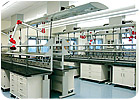
Example of a plug-in exhaust snorkel located in over head service carrier. (Photo courtesy of Gas Control Equipment, Inc.)
Establish a Benchmark
Establishing a benchmark within the function of the facility is crucial to size systems and equipment for the maximum foreseeable capacity.Most engineers with extensive lab experience have found that certain air changes per house (ach) and W/sq ft have historically worked well for them with certain types of labs. They do this because they do not typically have plug loads at their disposal or do not know the particular science that the researchers will be working on. It is difficult to obtain such information unless you have an existing operating facility, so the engineers play it safe and use conservative values, that may oversize the MEP equipment.
The largest contributor that affects capacity, particularly in the central plant, is the need for flexible ach in the facility. Lab spaces require 100% non-recirculated fresh air, which requires tremendous energy to condition. Laboratory fume hoods are the single most energy demanding pieces of laboratory equipment. Airflow is governed by the number of hoods, air changes, or by the heat load in the lab. Hood design is influenced by a wide variety of codes and standards that include but are not limited to those in Table 1. (Note: A very brief outline of the codes and standards are presented in Table1; therefore, the details of each code and standard should be carefully reviewed.)
Most engineers design around 100 fpm as the target capture velocity in hoods at a specific sash height. Some universities use a sash height of 10 in., some use 15, and some use the full sash opening to determine the airflow within the laboratory. Numerous articles, publications, engineering firms, and institutions cite 18 in. as the industry standard. Some engineers have found that certain rules of thumb pertaining to a specific type of science have historically worked well to size the building infrastructure. Some rules of thumbs are ach and W/sq ft as depicted in Table 2. These are typical values that an engineer might use to size MEP systems and depict the various criteria that he must consider when sizing systems. Some rules of thumb are based on industry standards while others are based on experience.
Most labs (with the exception of cleanrooms) can be handled with 6 ach and even down to 4 ach in unoccupied times.
We all understand the value engineering (VE) concept, which is to eliminate items in order to reduce capital cost for construction. An important concept to remember is to not VE out good engineering decisions or practice. You can implement good engineering decisions and practice as well as reduce capital cost by designing and installing only what you need and providing provisions for future growth.
When the science and actual loads are known, then use that actual information to size the installed equipment so that the facility will be functional properly from day one.
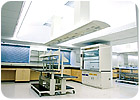
Example of lab module with movable furniture and overhead service carrier. (Photo courtesy of Gas Control Equipment, Inc.)
Laboratory flexibility
Flexibility in lab design can be summarized in two categories:- Shell and core flexibility
- Tenant fit-out flexibility
Shell and core is the large equipment conduit, pipes, ductwork, structure, and architectural features serving the entire building. Tenant fit-out is the equipment conduit, pipes, ductwork, structure, and architectural features serving the individual area, suite, or lab module within the building.
Overhead service distribution systems utilizing overhead service carriers (OSC) offer easy access to laboratory services such as electric, plumbing, gas outlets, exhaust snorkels, task lighting, data and phone connections. Changes in equipment and processes are easily accommodated without major remodeling and promote mobility, functionality, and laboratory efficiency. Installation time can be reduced significantly by pre-plumbing, pre-wiring, and pre-ducting the services. It is the OSC that plays an important part to tenant fit-out flexibility used in a modular lab module.
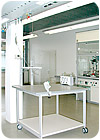
An example of a lab with flex pumping. (Photo courtesy of Gas Control Equipment, Inc.)
Engineers and architects will design generic labs, but they will be limited as to the function because capital costs limit the ability for a facility to be all things to all programs.
The building should be robustly designed and flexible enough to handle the most demanding equipment and research by providing more air changes and higher electrical loads as needed in the future. The facility should be able to grow with the program.
